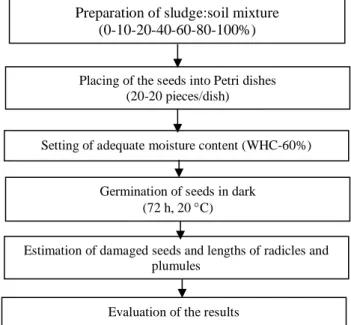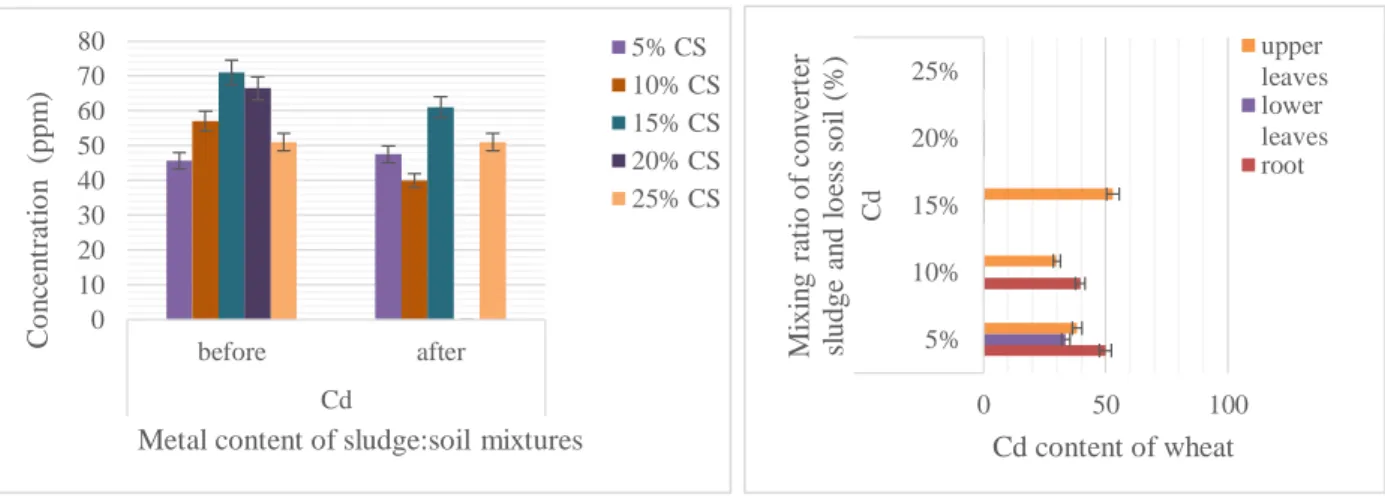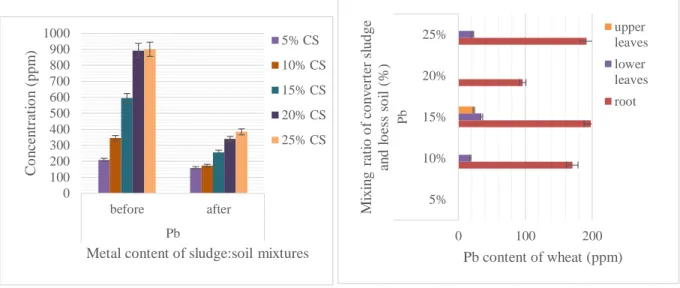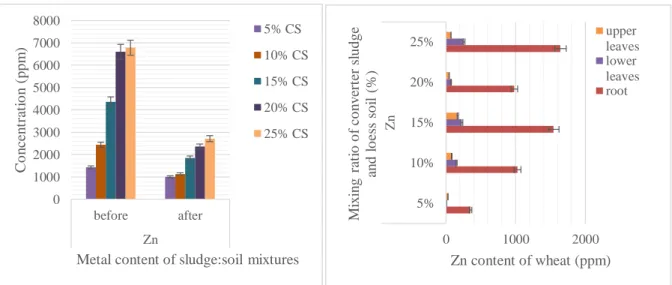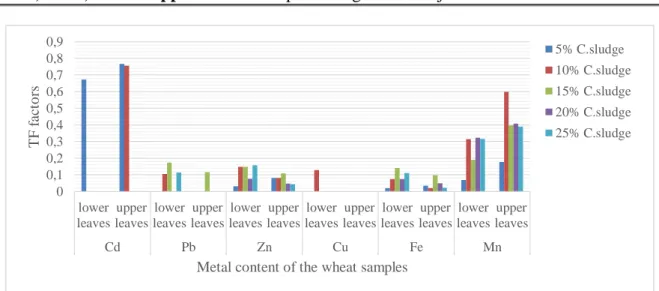Vol. 9, No. 4, 2019 pp. 88-100 http://doi.org/10.24368/jates.v9i4.150 13 88
http://jates.org
Journal of Applied
Technical and Educational Sciences jATES
ISSN 2560-5429
Phytoextraction potential of wheat and study on the applicable ratio of converter sludge in some soil-sludge
mixtures
Éva Kovács-Bokor a, Endre Domokos b
aUniversity of Dunaújváros, 1/A M. Táncsics St, Dunaújváros 2400, Hungary, kovacsbe@uniduna.hu
bUniversity of Pannonia, 10 Egyetem St, Veszprém 8200, Hungary, domokose@uni-pannon.hu
Abstract
Converter sludge is a by-product of the “steel industry”, at the wet cleaning process of the converter gas. The sludge might contain heavy metal oxides, more particularly of lead- (Pb) and zinc (Zn) oxides. Our aim is to investigate the accumulation ratio of these components within the different parts of some selected plants during the potential phytoremediation, phytoextraction processes. The investigation was implemented with the collaboration of students, who gained practical knowledge in sample preparation, analysis and data evaluation. The gained knowledge is a good complement to what the students have been learned in higher education and provides useful practical insights into environmental analysis. For the preparation of the laboratory experiment of this research, we made seedling growth tests with white mustard (Sinapis alba) seeds on the 20-40-60-80% mixtures of converter sludge and different kinds of soils. According to the germination results we determined that the most capable mixtures were the converter sludge and the loess mixtures. Wheat (Triticum aestivum) was chosen as a test plant for the experiments. The mixing ratio of the converter sludge was 5-10-15-20-25%. The metal content of the sludge-soil mixtures and the different parts of the wheat plants (shoot, root) were analyzed by XRF instrument. The results showed that the most effective and tolerable ratio of converter sludge can be the 10 and 15% in loamy soil mixtures. Wheat plants seem to be applicable on decreasing of the metal content from the sludge-soil mixtures. The decreasing average ratio was 50 % for Pb, 53 % for Zn, at using the lowest applied ratio into the soils. Further aim is to find other potential industrial plants for decreasing of the ratio toxic elements from the converter sludge.
Keywords: converter sludge; industrial plants; bioremediation-phytoextraction
1. Introduction
Industrial production of steel industry and the increasing population can have adverse effects on environmental quality (Biró, Szegi 1994). During the applied industrial processes many types of by-products, sludges and slags are produced, which contain metal oxides, or potentially toxic elements (PTE), which might become “heavy metals” in supra-optimal doses in the soil-plant-ecosystems (Mikanová et al. 2001). Within these metals, some of them (e.g.
cadmium, Cd and lead, Pb) might become especially toxic, due to the fact that they can have no or only weak vital roles (Vivas et al. 2003a, b, 2005). At some cases, e.g. at the rare-earth metals and at the nickel (Ni), there are great efforts for reusing them in the so-called
“phytomining” processes. It is potentially applicable if their concentration in the plant tissues can reach the 1% ratio, at least, to become economically feasible.
During the proposed research results the “converter sludge” of steal industry was selected from the so-called “industrial sludges” for the laboratory experiments.
The converter sludge was produced in the steel making process of ISD-Dunaferr Ltd. The company is using converter for making steel among some other (i.e. open-hearth steelmaking and electric steelmaking) technological solutions.During the operation of the converter, high pressure of oxygen is blown into the liquid metal, which results that CO gases and semi- metallic elements will be observed in the final sludge. At the end of the process, wet dust removal system is applied. Because of it, converter sludge contains a high concentration of ZnO, PbO and some other organic substances (Yaozu et al., 2020). The zinc concentration in the sludge of ISD-Dunaferr Ltd. is between 0,67-3,95%, the Pb content is about 0,2-0,4%.
Produced quantity of the sludge is around 30.000 tons/year, with the maximum Zn content is around 1185 tons/year (Márkus et al., 2011).
Zinc (Zn) and lead (Pb) can become toxic in the environment and are known to have a great bio-accumulation potential in the environment, and also in the soil-plant-animal-human food- chain (Vivas et al. 2005). Zinc is known as one of the “essential” elements, but in high,
“supraoptimal” concentration it can result several disorders in human health, i.e. lethargy, focal neuronal deficits, respiratory disorders, metal fume fever, nausea and might elevate the risk for cancer (Laura, 2010). Lead also might result health problems in adults, but more seriously in children. Lead (Pb) is accumulating within the human body in the bones and in teeth. It can increase the risk of high blood pressure and kidney damage (Vivas et al. 2003b).
In pregnant women Pb can result miscarriage, stillbirth, premature birth and low birth weight.
In case of children, the high lead exposure might result problems in the brain and in central nervous systems, and become more seriously as coma, convulsions and even death (WHO, 2019).
There are many chemical, physical and biological methods for reducing the metal content and the toxicity even of the various industrial sludge-types. Between the already known and
The technology is relatively non-expensive, and it is offer of the potential of reducing the hazardous element-content in the soils. During the phytoremediation techniques the environmentally hazardous chemicals are taken up by the plants (mainly industrial ones), so the elements will not going further and the accumulation is avoiding of the foods. The used plants can have an increased biomass-production, which might be used for the energy (heat, electricity) production. Furthermore, plants can absorb the CO2 content of the air, which is very important in reduction of greenhouse effect.
During the laboratory experiments, presented in this study, university students were also participating. This is part of our teaching activities, so as to provide applied research- industrial experiences. As it is shown in the presented work, students can become acquainted in significant methodologies (i.e, in collecting and preparation of samples, in environmental analyses methods and properly evaluating of scientific results. Our aim is to improve their practical knowledge on the field of soil protection, phytoremediation, as well as on the recovery of energy resources. Furthermore, we try to develop their sensitivity for the environmental protection and develop their global environmental way of thinking.
2. Methods
2.1. Seedling growth test
The white mustard seeds (Sinapis alba) as test plants were used, according to MSZ 21 976- 17:1993 Hungarian standard.
Fig. 1. Steps of the seedling growth test with mustard (Sinapis alba).
Preparation of sludge:soil mixture (0-10-20-40-60-80-100%)
Placing of the seeds into Petri dishes (20-20 pieces/dish)
Setting of adequate moisture content (WHC-60%)
Germination of seeds in dark (72 h, 20 C)
Estimation of damaged seeds and lengths of radicles and plumules
Evaluation of the results
Regarding the experiments, dried converter sludge, mixed with four different soils were used in Petri dishes; the ratio of sludge was 20-, 40-, 60-, 80 and 100 %. In each Petri dish 20 seeds of the white mustard were put onto the surface of soil: sludge mixture, watered by the 60% of total water-holding capacity. Experiment were done in three replicates. The main steps of the seedling growth test can be seen in Figure 1.
Considering the accumulation of the toxic metals in different parts of the test plants, the bioaccumulation-bioconcentration-translocation factors were calculated.
Bioaccumulation factor (BAF)
BAF is the ratio of metal concentration in the plant shoots to the used sludge:soil mixtures.
BAF = Cshoots/Csludge
where Cshoots is the metal concentration in the plant (plumules of seedling) and Csludge as metal concentrations in the sludge:soil mixtures. The BAF factor of the known hyper-accumulator plants are generally greater than 1 (Lago-Vila et al. 2015).
Bioconcentration factor (BCF)
BCF is the ratio of the metal contentration in every plant parts and in the sludge:soil mixtures.
BCF = Cplant parts/Csludge
where Cplant part is the metal concentration of the whole plants (plumules and radicles) and Csludge is the metal concentrations of the sludge:soil mixtures
Translocation factor (TF)
TF is the ratio between the metal content (ppm) in shoot of the test plant (Cshoots) to the roots (Croots).
TF = Cplant parts above the surface / Croots
when TF > 1, then it shows, that the metals were translocated from roots to shoots efficiently (Baker and Brooks, 1989; Lago-Vila et al. 2015).
The metal concentration in sludge:soil mixtures and the dried plants samples were analysed with XRF (X-ray flouroscence) instrument. It is widely used, because this equipment belongs to the non-destructive chemical analyses of minerals, alloys, sediments and soils. Each sample were measured in 3 replicates, assessment time was 30 sec.
3. Results
3.1. Results of industrial sludge:soil mixtures
Regarding the seedling growth tests, prepared by mixtures of converter sludge and the soils, four representative soil-types were selected for the experiments: S1 - “acidic brown forest soil” of Sopron mountain, S2 - sandy-loamy “chernozem soil” and S3 - “loamy” soil nearby of Dunaújváros, S4 - slightly “saline soil” from the Kiskunság region, Hungary.
The mixing ratio of the sludge was used, as 20-, 40-, 60-, 80- and 100%. We also made this test on 100% soils as controls. Among the used soils, the acidic brown forest soil had the lowest pH value (pH=4.5) (Fig. 2.).
Fig.2. The pH values of the test soils
Among the mixtures of the converter sludge and the four soils, loamy (S3) and chernozem (S2) soils showed the best germination results. When these soils were mixed to converter sludge, the ratio of the pullulated seeds were higher (Fig. 3.) at the 20 and 40% mixtures.
Longer radicles and plumules were observed in these mixtures (Fig. 4.). When we compared the controls to their 20% mixtures with converter sludge, it can be determined that the presence of the sludge could stimulate the growing of the seeds (Kovács-Bokor et al, 2019).
Fig. 3. The ratio of the pullulated seeds on the mixtures of converter sludge and soils
0,0 5,0 10,0
S1 S2 S3 S4
pH value
Test soils
0 10 20 30 40 50 60 70 80 90 100
CS+S3 CS + S2 CS + S1 CS + S4
Ratio of the pullulated white mustard seeds (%)
Mixtures of CS and soils
100 % soil 80 % CS 60 % CS 40% CS 20% CS
Fig. 4. The length of radicles and plumules on the mixtures of converter sludge (CS) and soils 3.2. Metal concentrations in sludge:soil mixtures and in wheat seedlings
According to the results of the seedling growth test, converter sludge (CS) and S3 - “loamy”
soil were used as the sludge:soil mixture.
3.2.1. The Cd concentration
Based on Figure 5. the Cd content of the sludge-soils samples exceeded the Hungarian standard levels, which is 1 mg/kg (KvVM-EüM-FVM Regulation No 6/2009). When the final result of the metal concentration was compared to the beginning state, Cd content of the 10 and 15% sludge-soil mixtures decreased.
Fig. 5. Cd content of the soil-sludge mixtures and the plant-parts of the wheat Higher Cd concentration was detected mainly in the roots of wheat samples (Fig. 5.). In the case of the 5% and 10% mixtures could accumulate this toxic element into the higher part (lower and upper leaves) of the test plant. The cadmium concentration was higher in the test plants than the permissible Hungarian limit of 0.5 mg/kg (Simon 2006, Szegedi 2011).
-35 -25 -15 -5 5 15 25
plumule radicle plumule radicle plumule radicle plumule radicle
CS+S3 CS + S2 CS + S1 CS + S4
Lengths of radicles and plumules of white mustard seeds (mm)
Mixtures of CS and soils
100 % soil 80 % CS 60 % CS 40% CS 20% CS
0 10 20 30 40 50 60 70 80
before after
Cd
Concentration (ppm)
Metal content of sludge:soil mixtures
5% CS 10% CS 15% CS 20% CS 25% CS
0 50 100
5%
10%
15%
20%
25%
Cd
Cd content of wheat Mixing ratio of converter sludge and loess soil (%) upper
leaves lower leaves root
3.2.2. The Pb concentration
The Hungarian standard level for Pb content is 100 mg/kg (KvVM-EüM-FVM Regulation No 6/2009). According to the Figure 6, the Pb content of the mixtures was higher than this limit value. Lead content decreased as a result of the phytoextraction experiment in each mixture.
Fig. 6. Pb content of the soil-sludge mixtures and the main parts of the wheat samples The leaves of the test plant could not accumulate lead in higher quantity in comparison with root samples (Fig.6.). Among the mixtures, 15% mixing ratio was the most effective, because in this case lead could translocated from the roots to the leaves. The accumulated lead concentration was within the permissible Hungarian limit, which is between 30-300 mg/kg (Simon 2006, Szegedi 2011).
3.3.3. The Cu concentration
Copper (Cu) belongs to the group of, so called “essential elements”. Based on the Figure 7, the Cu concentration of the sludge-soil mixtures was under the Hungarian standard limit of 75 mg/kg (KvVM-EüM-FVM Regulation No 6/2009). According to the results, the quantity of copper decreased in the samples, but further experiments are needed for it, because this element could not be observed in the test plants.
The test plant was not able to accumulate copper (Fig. 6.). Comparing the roots and the leaves of the wheats, roots contained Cu in higher levels at the 10 and 15% mixtures. The Cu contamination of the samples was above the Hungarian preferable limit value of 35 mg/kg (Simon 2006, Szegedi 2011).
0 100 200 300 400 500 600 700 800 900 1000
before after Pb
Concentration (ppm)
Metal content of sludge:soil mixtures 5% CS 10% CS 15% CS 20% CS 25% CS
0 100 200
5%
10%
15%
20%
25%
Pb
Pb content of wheat (ppm) Mixing ratio of converter sludge and loess soil (%)
upper leaves lower leaves root
Fig. 7. Cu content of the soil-sludge mixtures and the main parts of the wheat samples 3.2.4. The Zn concentration
Zinc (Zn) is also belongs to the group of the “essential elements”. Based on the Fig. 8., the Zn concentration of the sludge-soil mixtures decreased. The Zn content of the mixtures exceeded the Hungarian standard limit, which is 200 mg/kg (KvVM-EüM-FVM Regulation No 6/2009).
Higher Zn content was mainly detected from the roots of the test plant. The efficiency of the accumulation was higher at 10, 15 and 25% mixtures, because Zn could translocate from roots to leaves in higher rate from these mixtures. The Zn concentration of the roots exceeded the tolerable value, which is 250 mg/kg (Simon 2006, Szegedi 2011).
Fig. 8. Zn content of the soil-sludge mixtures and the main parts of the wheat samples
0 5 10 15 20 25 30 35 40 45
before after Cu
Concentration (ppm)
Metal content of the sludge:soil mixtures 5% CS 10% CS 15% CS 20% CS 25% CS
0 50 100
5%
10%
15%
20%
25%
Cu
Cu content of wheat Mixing ratio of converter sludge and loess soil (%) upperleaves
lower leaves root
0 1000 2000 3000 4000 5000 6000 7000 8000
before after Zn
Concentration (ppm)
Metal content of sludge:soil mixtures 5% CS 10% CS 15% CS 20% CS 25% CS
0 1000 2000
5%
10%
15%
20%
25%
Zn
Zn content of wheat (ppm) Mixing ratio of converter sludge and loess soil (%)
upper leaves lower leaves root
3.2.5. The Mn concentration
Based on the Figure 9, manganese concentration of the sludge-soil mixtures decreased up till the end of the experiment.
Fig. 9. Mn content of the soil-sludge mixtures and the main parts of the wheat samples Mn accumulation was more effective than Zn accumulation. Mn content was also mainly detected from the roots of the test plant, but at every mixtures Mn could translocate from the roots to the higher parts (leaves) of the wheat in higher rate.
3.2.6. The Fe concentration
Based on the Figure 10, iron (Fe) concentration of the sludge-soil mixtures also decreased, due to the bioaccumulation by the wheat plants.
Fe accumulation was very similar to the Mn accumulation. The highest concentrations were detected from the roots, but the plant could accumulate this element into the shoots. The Fe can be translocating within the test plants very easily.
Fig. 10. Fe content of the soil-sludge mixtures and the main parts of the wheat samples
0 20000 40000 60000 80000 100000 120000 140000
before after Fe
Concentration (ppm)
Metal content of sludge:soil mixtures 5% CS 10% CS 15% CS 20% CS 25% CS
0 20000 40000
5%
10%
15%
20%
25%
Fe
Fe content of wheat (ppm) Mixing ratio of converter sludge and loess soil (%) upper
leaves lower leaves root 0
500 1000 1500 2000 2500 3000
before after Mn
Concentration (ppm)
Metal content of sludge:soil mixtures 5% CS 10% CS 15% CS 20% CS 25% CS
0 1000 2000
5%
10%
15%
20%
25%
5%
10%
15%
20%
25%
MnZn
Mn content of wheat (ppm) Mixing ratio of converter sludge and loess soil (%) upper
leaves lower leaves root
3.3. Bioaccumulation, bioconcentration and translocation factors in wheat
The bioaccumulation factor (BAF) for Cd, Pb, Zn, Cu, Fe and Mn was generally less, than 1, only the BAF factor of Cd was higher than >1 in the case of the 5-10-15% sludge-soil mixtures (Fig.11.). The trend of BAF for toxic metals was in the order of Cd>Mn>Zn>Fe>Pb>Cu.
Fig. 11. Bioaccumulation factor (BAF) of some studied elements in wheat samples In the case of bioconcentration factor, the values were below 1. Between the main parts of the wheat plant (roots, leaves), roots could accumulate the measured metals in higher ratio (Fig.
12.)
Fig. 12. Bioconcentration factor (BCF) of wheat samples
The TF factor for every element was <1 (Fig. 13.). This result showed that in wheat samples the metals were not translocated effectively, from the roots to the leaves (Baker- Brooks 1989; Lago-Vila et al. 2015). The order of TF factors is: Cd>Mn>Zn>Fe>Pb>Cu.
0 0,5 1 1,5
Zn Cd Pb Cu Fe Mn
BAF factors
Metal content of the wheat samples
5% C.sludge 10% C.sludge 15% C.sludge 20% C.sludge 25% C.sludge
0,20 0,40,6 0,81 1,21,4
roots lower leaves upper leaves roots lower leaves upper leaves roots lower leaves upper leaves roots lower leaves upper leaves roots lower leaves upper leaves roots lower leaves upper leaves
Cd Pb Zn Cu Fe Mn
BCF factors
Metal content of the wheat samples
5% C.sludge 10% C.sludge 15% C.sludge 20% C.sludge 25% C.sludge
Fig. 13. Translocation factor (TF) of wheat samples
4. Conclusions
The metal concentration in the sludge:soil mixtures was measured before and after the phytoextraction experiment. The Cd, Pb and Zn content of the mixtures were above the Hungarian standard limits. Wheat had a positive effect on the concentration of the metals.
Metal content of the mixtures decreased at the end of the experiments. The average quantity of the heavy metals of the soil:sludge mixtures was found to be decreased by wheat. The average decreasing ratio was 53% for Zn, 50% for Pb and 44% for Mn.
The metal content of the wheat samples was also analysed. The wheat samples could accumulate these metal elements in higher ratio, except of Cd and Cu. BAF, BCF and TF factor for Cd, Pb, Cu, Zn, Mn and Fe were mainly <1. The BCF of the roots was around 1 in the case of Cd, Pb, Zn and Mn. According to these results, roots could accumulate the measured elements in higher ratio than the shoots. The most effective sludge-soil mixtures were 10 and 15%. The trend of BAF and TF for heavy metals was in the order of Cd>Mn>Zn>Fe>Pb>Cu. Because the TF factor was <1 for every element, wheat could not translocate the toxic metals, in comparison with the hyperaccumulator plants. Further research is needed to find other adequate test-plants and soils with higher phytoextraction efficiency.
It is very important to mention, that students were participating in the experiments. They could be able to involve in the laboratory work, included in learning of the main assessment methods and it was a great facility of developing of their critical evaluation capacity. The potential use of up to date analytical methods was also learned, regarding the proper environmental protection.
0 0,1 0,2 0,3 0,4 0,5 0,6 0,7 0,8 0,9
lower leaves
upper leaves
lower leaves
upper leaves
lower leaves
upper leaves
lower leaves
upper leaves
lower leaves
upper leaves
lower leaves
upper leaves
Cd Pb Zn Cu Fe Mn
TF factors
Metal content of the wheat samples
5% C.sludge 10% C.sludge 15% C.sludge 20% C.sludge 25% C.sludge
5. Acknowledgements
Thanks for the support of EFOP-3.6.2-16-2017-00018 „Produce together with the nature – agroforestry as a new outbreaking possibility” project.
6. References
Yaozu W., Zhengjian L., Jianliang Z., Rui M., Yapeng Z. (2020): Advanced converter sludge utilization technologies for the recovery of valuable elements: A review, J. Hazardous Materials, 381 (5); doi:10.1016/ j.jhazmat.2019.120902
Biró B., Szegi J. (1994): Some problems of soil contamination and remediation in Hungary.
Acta Biol. Debrecina Oecol. Hung., 5: 483-488.
Biró B., Posta K., Füzy A., Kádár I., Németh T. (2005): Mycorrhizal functioning as part of the survival mechanisms of barley (Hordeum vulgare L) at long-term heavy metal stress. Acta Biol. Szegediensis, 49: 65-68.
Márkus R., Grega O. (2011): Veszélyes hulladéknak minősülő ipari eredetű porok és más hulladékok veszélyességének megszüntetése, hasznosítási lehetőségeik kidolgozása.
Retrieved from http://anyagokvilaga.hu/tartalom/2011/1/osszefoglalo.pdf
Mikanová O., Kubát J., Mikhailovskaya N., Vörös I., Biró B. (2001): Influence of heavy metal pollution on some biological parameters in the alluvium of the Litavka river. Rostlynna Výroba, 47: 117-122.
Laura M. P., Lothar R. and Hajo H. (2010): The Essential Toxin: Impact of Zinc on human health, Int. J. Environ. Res. Public Health, 7: 1342-1365; doi:10.3390/ijerph7041342
WHO: Lead poisoning and health (2019), Retrieved from https://www.who.int/news- room/fact-sheets/detail/lead-poisoning-and-health
Simon L. (2004): Fitoremediáció. Budapest. BMKE OMIKK. ISBN: 963 593 429 0
Szegedi L. (2011): Toxic heavy-metal contamination and its after-effect on brown forest soil.
PhD dissertation, Szent Istvan University, Gödöllő, Hungary (in Hungarian)
Al-Hwaiti M., Al-Khashman O. (2015): Health risk assessment of heavy metals contamination in tomato and green pepper plants grown in soils amended with phospogypsum waste materials. Environm. Geochem. Health, 37: 287-304.
Baker A.J.M., Brooks R.R. (1989): Terrestrial higher plants which hyperaccumulate metallic elements - a review of their distribution, ecology and phytochemistry, Biorecovery, 1: 81-126.
Lago-Vila M., Arenas-Lago D., Rodríguez-Seijo A., Andrade Couce M.L., Vega F.A. (2015):
Cobalt, chromium and nickel contents in soils and plants from a serpentinite quarry. Solid Earth, 6, 323–335.
Kovács-Bokor É., Domokos E., Kiss E (2019): Effect of industrial sludge-soil mixtures on germination of white mustard and wheat, J. Applied Technical and Educational Sciences, 9 (1): 66-78., doi:10.24368/jates.v9i1.87I:
Vivas A., Vörös I., Biró B., Campos E., Barea J.M., Azcón R. (2003a): Symbiotic efficiency of autochthonous arbuscular mycorrhizal fungus (G. Mossae) and Brevibacillus sp. isolated from Cd-polluted soil under increasing Cd levels. Environmental Pollution, 126: 179-189.
Vivas A., Azcon R., Biró B., Barea J.M., Ruiz-Lozano J.M. (2003b): Influence of two bacterial strains from a Pb-polluted soil on plant growth and on arbuscular mycorrhizal functioning under Pb toxicity. Canadian J. Microbiology, 49: 577-588.
Vivas A., Biró B., Ruíz-Lozano JM, Barea JM, Azcón R. (2006): Two bacterial strains isolated from a Zn-polluted soil enhance plant growth and mycorrhizal efficiency under Zn- toxicity. Chemosphere, 62: 1523-1533.
Short professional biography
Éva Kovács-Bokor is an assistant research fellow at the University of Dunaújváros and PhD student at University of Pannonia. She is involved in teaching the subjects, as “Renewable energy resources”, “Waste management”, “Conservation, Environmental Protection and Safety”. She is taking part in some national and EU-funded applied and research projects. She is graduated as a teacher of the environmental studies (in 2008–2009) at the University of Szeged, Faculty of Natural Sciences and Informatics. Her PhD topic and research field is the “Monitoring of mobilization and content of heavy metals; and reduction of heavy metals by physical-chemical and biological (phytoextraction) methods”.
Endre Domokos, PhD is an asssociate professor and head, Institute of Environmental Engineering, Faculty of Engineering, at University of Pannonia, Hungary. His PhD topics were the computer simulation, modelling, energy management at sewage cleaning technologies. His research projects focus on the modelling of sewage - water plants with special emphasis of the practices of the optimizations processes. He has extensive experience from methodical investigations which are related to the construction of e-learning curriculums. He is a member of the “Hungarian Sewage Cleaning Association” and the “Chemical Technological and Environmental Protection” Working Committee of MTA (Hungarian Academy of Sciences).
